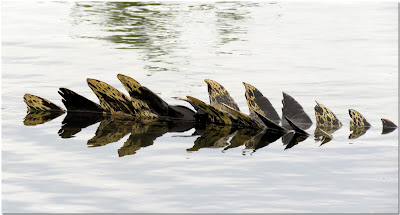It's the best known park in the Northern Territory and probably Australia for that matter and is very large covering over 19,000 square kilometres.
The park consists of amazing escarpment country with rivers, billabongs, wetlands and the largest concentration of Aboriginal rock art sites in Australia. Some of this art has been dated at over 20.000 years old.
Because there is so much water about and because it's always quite hot it also has a huge population of mosquitoes.
So whatever you do don't forget the mozzie repellent.
One-third of Australia's birds live within the Park along with many species of reptiles, insects, fish, dingoes and kangaroos.
Probably the only really safe water in the park to swim in are the swimming pools at Jabiru and at Cooinda Resort although we will also be swimming at Gunlom Falls
Because the park is so large all the sites are spread out over a large area.
Our intention was to spend four days camped at Gunlom Falls but when we stopped at the Mary River Roadhouse for refreshments they advised us that the dirt road into Gunlom and been closed due to recent unseasonal rains.
This would have been the second visit for Ros, and I have been here many times. When I lived in Darwin in the seventies we would camp at Gunlom Falls. Then it was known as UDP Falls or Uranium Developing and Prospecting Company Falls.
In those days we were able to drive our vehicles right up beside the waterhole and camp, but now you almost have to take a cut lunch just to get here.
Our only alternative was to stick to the bitumen and head to Cooinda and book into the caravan park at the resort.
On our way the dirt access roads into Barramundi and Graveside Gorges were also closed. For the next 100 km until we entered the access road into Cooinda both sides of the Kakadu Highway had pools of water lying beside the road. We found out later that the track into Twin and Jim Jim Falls were also closed and will remain that way for sometime.
We booked in for four nights at $46 per night for a powered site, paid our park fees with each getting a reduction by showing our NSW senior passes, paid for a sunrise and sunset tour on the Yellow Water Wetlands with a full cooked breakfast thrown in for good measure and a 50% reduction for the sunset tour.
The wetland boat tours operate up to six times daily during the dry season with the sunrise and sunset tours being the most popular.
That afternoon we spent several hours in one of the two pools at the resort before retiring to the air conditioned comfort of the van until we ventured outside for our happy hour.
Some photos from this morning's sunrise wetland tour....
The front end...
And the other end....
Unfortunately the Azure Kingfishers were too flighty this morning and I was unable to get a good shot of the many that we saw.
Thank goodness we went on the sunrise tour because the bird life was almost non existent this afternoon.
However the sunset photos and this silhouette of a White Breasted Sea-eagle eating this Barra helped make up for this.
These photos were taken from the Gunwarddehwardde Lookout at Nourlangie.
We also visited the Nawurlandja Lookout which involved climbing a 300 metre moderately steep slope with views east of Nourlangie and the escarpment.
When we left Cooinda we had planned to camp at the Merl Campground near Cahills Crossing. But with the higher daytime temperatures and very high humidity we have opted to stay in the Jabiru township at the Kakadu Lodge for three days. That gives us power to run the air con. It wasn't a great day's drive with just over 50 km to travel. The site has many forms of accommodation along with a restaurant and bar but best of all a pool for the guests to use.
The campground is in a huge circular configuration comprising 169 sites that surround the pool area, restaurant and bar. Being so late in the season there were only about another 12 sites being used on our arrival so choosing a site was easy peasy.
The major attractions close by are the Ubirr rock art galleries and Cahills Crossing on the East Alligator River. The river crossing has been closed for the past several days because of the unseasonal rain that has been experienced however it opened on the day we visited. The East Alligator River is the border between Kakadu and Arnhem Land and I read that this river's claim to fame is that it's the second most crocodile populated river in the world. Only the Nile has more.
These guys were tempting fate especially fishing from the crossing...they were unable to land this Barra and it made its way back into the river.
The main gallery illustrates X-ray paintings from the last 1500 years. You can view the art via a 1 km circuit walk and there is a 250 metre climb to the Nardab lookout which overlooks the flood plains below.









































































